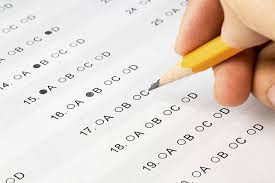Q: What is the best way to study for a multiple-choice test?
- A. Review the material for the first time as you drive to school
- B. Follow this informative set of guidelines
- C. “Work together” with the smart kid who sits in front of you
 Multiple choice is a commonly chosen format for math exams in both primary and secondary education. Some of the pros of multiple-choice exams are that there are usually many more questions than on an essay or “fill in your answer” test. This means questions are worth fewer points and assume less risk. The answer is guaranteed to be one of the given choices, so a lucky guess is always a possibility.
Multiple choice is a commonly chosen format for math exams in both primary and secondary education. Some of the pros of multiple-choice exams are that there are usually many more questions than on an essay or “fill in your answer” test. This means questions are worth fewer points and assume less risk. The answer is guaranteed to be one of the given choices, so a lucky guess is always a possibility.
The cons, however, are that since there are so many questions, the student is required to have a broader knowledge of the subject instead of knowing a lot about one or two concepts. It is not easy to weasel your way to the right answer on a multiple-choice test like it is on essay exams. You either have the right answer, or you don’t—there’s no interpretation or half credit available.
Through years of test-taking and research, there have been a few guidelines set up for how to be as successful as possible when taking a multiple-choice exam.
1. Start Studying Early ⏰
There is a lot to cover and cramming the night before the test is not effective. You’ll end up confusing yourself more if you try to memorize concepts and formulas in a rush. By giving yourself plenty of time to read, practice, and absorb each section of the chapter, you will have a better understanding of the subject and know more of the correct answers.
2. Brainstorm Possible Questions 🤔
Brainstorm alone, with your tutor, or with other classmates to think of examples of questions that might appear on the test. Quiz each other with multiple-choice answers to get some practice finding the correct answer.
3. Read the Question First 📝
When it’s time to take the test, read the question and use your hand or a piece of paper to cover the multiple-choice options. This way, you can think about the problem without the extra words/numbers distracting you. Solve the problem and then look to see if your answer is there. If it is, select it but make sure to double-check that there isn’t a better answer.
4. Pay Attention to Words like “Always” or “Never”
Answers containing words like “always” and “never” are less likely to be correct compared to answers with words like “usually” or “probably.”
5. “All of the Above” is Usually Correct
First, make sure you can pinpoint at least two answers that correctly answer the question before choosing “All of the Above.”
6. Use Your English Skills 📚
If the question ends with “an,” the answer is likely to start with a vowel. This may help eliminate a few wrong answers.
7. Look for Repetition
If many of the keywords in the answer are repeated from the question, that answer is likely to be correct.
8. Guess “B” or “C” When Stumped
Subconsciously, teachers often hide the correct answer amongst the choices. If you’re absolutely stumped and have to guess, try “B” or “C” instead of “A.”
These guidelines are, of course, just guidelines. They should not be relied upon as a study method but should instead be considered as a few things to keep in mind when studying for a multiple-choice exam. The best way to be successful on a multiple-choice exam is to study early and often, take copious notes, ask questions when you have them, attend all of your classes, and seek outside help from a tutor if you are struggling.
PS: The answer to the multiple-choice question at the beginning of this article is B.





